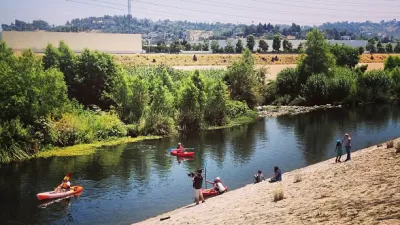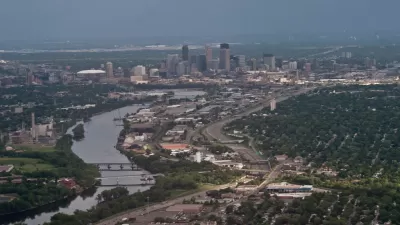Jon Christensen urges Los Angeles to ensure that new park amenities serve, rather than displace, the river's low-income communities.

As Los Angeles solicits public input on a park considered a key piece of the L.A. River revitalization, Jon Christensen ponders whether the city can achieve an "equitable and just greening." In a piece for CityLab, he offers more questions than answers about how to ensure the future of the low-income communities surrounding the river project.
While green spaces and parks yield important benefits to those with access to them, "improved parks, like other positive amenities—cool retail, coffee shops, fresh produce—are correlated with gentrification, in some cases," he writes.
That's a problem that Los Angeles will have to contend with as the promise of a naturalized river attracts real-estate investment that could threaten existing residents. Recently, the core community group Friends of the Los Angeles River (FOLAR)—whose decades of advocacy helped mainstream the revitalization effort—opposed a major housing development on the waterfront that didn’t include enough affordable units.
Last year, FOLAR published a guide to riverfront development focused on equity and affordability. Still, Christensen laments:
"Right now, we don’t have any really good models for inclusive green development that can lift up communities in place while providing the access to nature, open space, and recreational opportunities that we know are so important to the health of people and their neighborhoods."
FULL STORY: Can the L.A. River Avoid 'Green Gentrification'?

Study: Maui’s Plan to Convert Vacation Rentals to Long-Term Housing Could Cause Nearly $1 Billion Economic Loss
The plan would reduce visitor accommodation by 25,% resulting in 1,900 jobs lost.

North Texas Transit Leaders Tout Benefits of TOD for Growing Region
At a summit focused on transit-oriented development, policymakers discussed how North Texas’ expanded light rail system can serve as a tool for economic growth.

Why Should We Subsidize Public Transportation?
Many public transit agencies face financial stress due to rising costs, declining fare revenue, and declining subsidies. Transit advocates must provide a strong business case for increasing public transit funding.

How to Make US Trains Faster
Changes to boarding platforms and a switch to electric trains could improve U.S. passenger rail service without the added cost of high-speed rail.

Columbia’s Revitalized ‘Loop’ Is a Hub for Local Entrepreneurs
A focus on small businesses is helping a commercial corridor in Columbia, Missouri thrive.

Invasive Insect Threatens Minnesota’s Ash Forests
The Emerald Ash Borer is a rapidly spreading invasive pest threatening Minnesota’s ash trees, and homeowners are encouraged to plant diverse replacement species, avoid moving ash firewood, and monitor for signs of infestation.
Urban Design for Planners 1: Software Tools
This six-course series explores essential urban design concepts using open source software and equips planners with the tools they need to participate fully in the urban design process.
Planning for Universal Design
Learn the tools for implementing Universal Design in planning regulations.
City of Santa Clarita
Ascent Environmental
Institute for Housing and Urban Development Studies (IHS)
City of Grandview
Harvard GSD Executive Education
Toledo-Lucas County Plan Commissions
Salt Lake City
NYU Wagner Graduate School of Public Service





























